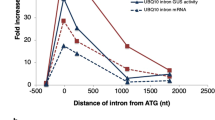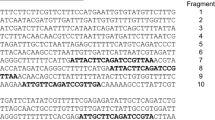Abstract
Plant introns are generally short (<200 nt) and AU-rich, and an elevated AU content is necessary for efficient splicing. Further, an intron in some plant genes enhances gene expression by a post-transcriptional mechanism that results in an increase of cytoplasmic mRNA. The specific intron features responsible for efficient splicing and enhancement are not well characterized in plants. Internal deletions of up to 80% of two maize introns, Adh1 intron 1 and maize actin intron 3, indicate that large segments of these introns are dispensable for normal function. However, extensive deletion (>75%) of Adh1 intron 1 diminishes both intron enhancement and splicing efficiency. This finding suggests that there are internal sequence motifs required for intron function, and that these motifs are redundant. We attempted to repair a deletion-impaired Adh1 intron 1 variant by adding back either oligomers of defined sequence content or fragments of maize internal intron sequence. The addition of AU-rich oligomers improved splicing efficiency and in one example, a U-rich oligomer activated a cryptic 3′ splice acceptor. We also found that replacing the region proximal to the Adh1 intron 1 3′ acceptor with U-rich sequence improved splicing. We found that adding G- and C-rich oligomers did not improve intron function, but a C-rich oligomer activated a cryptic 3′ acceptor. The addition of internal intron sequence to an impaired intron improved splicing, and in one case, resulted in the activation of a cryptic 3′ acceptor. We present evidence that U-rich sequence immediately upstream of the 3′ splice junction increases splicing efficiency and contributes to, but does not uniquely specify, 3′ acceptor AG choice.
Similar content being viewed by others
References
Buchman AR, Berg P: Comparison of intron-dependent and intron-independent gene expression. Mol Cell Biol 8: 4395–4405 (1988).
Callis J, Fromm M, Walbot V: Introns increase gene expression in cultured maize cells. Genes Devel 1: 1183–1200 (1987).
Csank C, Taylor FM, Martindale DW: Nuclear pre-mRNA introns: analysis and comparison of intron sequences from Tetrahymena thermophila and other eukaryotes. Nucl Acids Res 18: 5133–5141 (1990).
Dean C, Favreau M, Bond-Nutter D, Bedbrook J, Dunsmuir P: Sequences downstream of translation start regulate quantitative expression of Petunia rbcS genes. Plant Cell 1: 201–208 (1989).
Dennis ES, Gerlach WL, Pryor AJ, Bennetzen JL, Inglis A, Llewellyn D, Sachs MM, Ferl RJ, Peacock WJ: Molecular analysis of the alcohol dehydrogenase (Adh1) gene of maize. Nucl Acids Res 12: 3983–4000 (1984).
Evans MJ, Scarpulla RC: Both upstream and intron sequence elements are required for elevated expression of the rat somatic cytochrome c gene in COS-1 cells. Mol Cell Biol 8: 35–41 (1988).
Goodall GJ, Filipowicz W: The AU-rich sequences present in the introns of plant nuclear pre-mRNAs are required for splicing. Cell 58: 473–483 (1989).
Goodall GJ, Filipowicz W: The minimum functional length of pre-mRNA introns in monocots and dicots. Plant Mol Biol 14: 727–733 (1990).
Goodall GJ, Filipowicz W: Different effects of intron nucleotide composition and secondary structure on pre-mRNA splicing in monocot and dicot plants. EMBO J 10: 2635–2644 (1991).
Guthrie C: Messenger RNA splicing in yeast: clues to why the spliceosome is a ribonucleoprotein. Science 253: 157–163 (1991).
Guthrie C, Patterson B: Spliceosomal snRNAs. Annu Rev Genet 22: 387–419 (1988).
Hanley BA, Schuler MA: Plant intron sequences: evidence for distinct groups of introns. Nucl Acids Res 16: 7159–7176 (1988).
Hawkins JD: A survey of intron and exon lengths. Nucl Acids Res 16: 9893–9908 (1988).
Huang MTF, Gorman CM: Intervening sequences increase efficiency of RNA 3′ processing and accumulation of cytoplasmic RNA. Nucl Acids Res 18: 937–947 (1990).
Lou H, McCullough AJ, Schuler MA: 3′ splice site selection in dicot plant nuclei is position dependent. Mol Cell Biol 13: 4485–4493 (1993).
Lou H, McCullough AJ, Schuler MA: Expression of maize Adh1 intron mutants in tobacco. Plant J 3: 393–403 (1993).
Luehrsen KR, de Wet JR, Walbot V: Transient expression analysis in plants using firely luciferase reporter gene. Meth Enzymol 216: 397–414 (1992).
Luehrsen KR, Taha S, Walbot V: Nuclear pre-mRNA splicing in higher plants. Prog Nucl Acids Res Mol Biol 47: 149–193 (1994).
Luehrsen KR, Walbot V: Intron enhancement of gene expression and the splicing efficiency of introns in maize cells. Mol Gen Genet 225: 81–93 (1991).
Luehrsen KR, Walbot V: Insertion of non-intron sequence into maize introns interferes with splicing. Nucl acids Res 20: 5181–5187 (1992).
Luehrsen KR, Walbot V: Intron creation and polyadenylation in maize are directed by AU-rich RNA. Submitted (1993).
McElroy D, Zhang W, Cao J, Wu R: Isolation of an efficient actin promoter for use in rice transformation. Plant Cell 2: 163–171 (1990).
Patterson B, Guthrie C: A U-tract enhances usage of an alternative 3′ splice site in yeast. Cell 64: 181–187 (1991).
Robberson BL, Cote GJ, Berget SM: Exon definition may facilitate splice site selection in RNAs with multiple exons. Mol Cell Biol 10: 84–94 (1990).
Rossi P, de Crombrugghe B: Identification of a cell-specific transcriptional enhancer in the first intron of the mouse alpha-2(type I) collagen gene. Proc Natl Acad Sci USA 84: 5590–5594 (1987).
Ruby SW, Abelson J: Pre-mRNA splicing in yeast. Trends Genet 7: 79–85 (1991).
Solnick D, Lee SI: Amount of RNA secondary structure required to induce an alternative splice. Mol Cell Biol 7: 3194–3198 (1987).
Steitz JA: Splicing takes a Holliday. Science 257: 888–889 (1992).
van Santen SV, Spritz RA: Splicing of plant pre-mRNAs in animal systems and vice versa. Gene 56: 253–265 (1987).
White O, Soderlund C, Shanmugan P, Fields C: Information contents and dinucleotide compositions of plant intron sequences vary with evolutionary origin. Plant Mol Biol 19: 1057–1064 (1992).
Wiebauer K, Herrero JJ, Filipowicz W: Nuclear pre-mRNA processing in plants: distinct modes of 3′-splicesite selection in plants and animals. Mol Cell Biol 8: 2042–2051 (1988).
Wieringa B, Hofer E, Weissmann C: A minimal intron length but no specific internal sequence is required for splicing the large rabbit β-globin intron. Cell 37: 915–925 (1984).
Author information
Authors and Affiliations
Rights and permissions
About this article
Cite this article
Luehrsen, K.R., Walbot, V. Addition of A- and U-rich sequence increases the splicing efficiency of a deleted form of a maize intron. Plant Mol Biol 24, 449–463 (1994). https://doi.org/10.1007/BF00024113
Received:
Accepted:
Issue Date:
DOI: https://doi.org/10.1007/BF00024113




